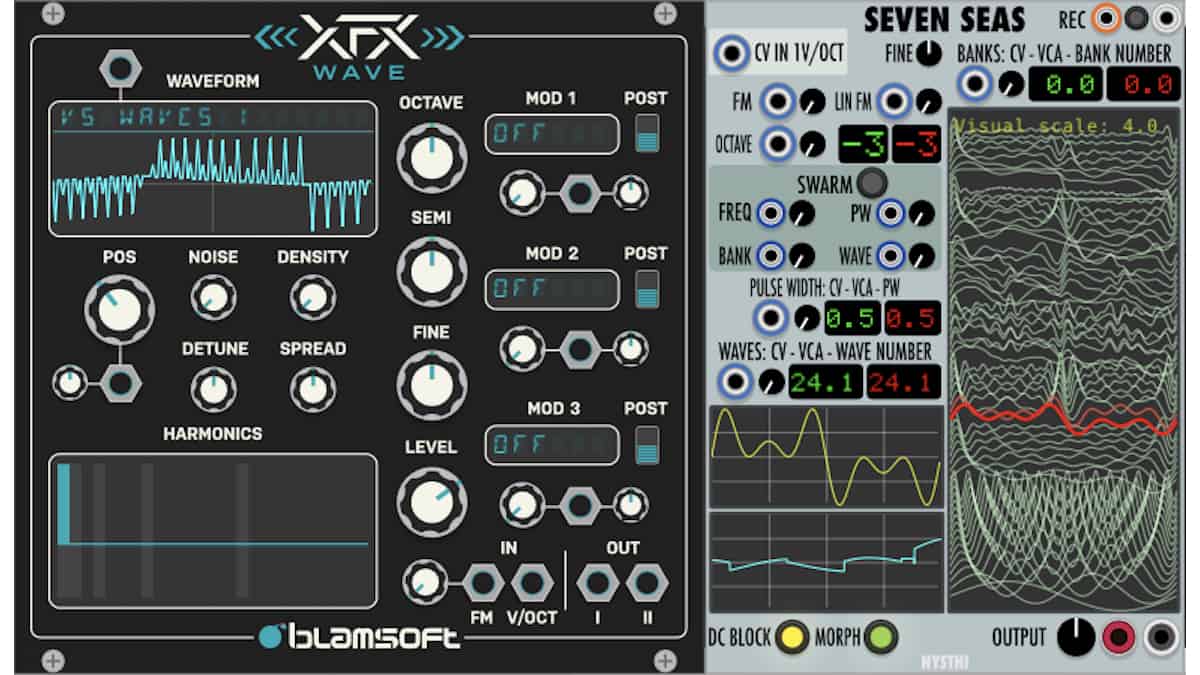Columns
Modular Synthesis for Beginners: Wavetable Synthesis

The heart of many synths is a wavetable oscillator, but what the heck are wavetables?
Filling your mix with fresh, exciting sounds is what electronic music is all about. You can find lots of ways to do this, of course. You could search through thousands of presets, for instance, to find the one that inspires you. (That’s not this month’s topic, though.) If you ever create your own sounds, you’ll want to know about wavetable synthesis. It’s one of the easier and more effective ways of finding a tone color that will sit well in the mix. It also gives us a great way to add movement to an oscillator’s tone.
A Wavetable Is a List of Numbers
In order to explain what wavetable synthesis is, we need to take a small step backward. You have two basic ways to make sound electronically: you can either generate the tone in real time or play back something created earlier and saved in a storage medium. All true analog synths, for example, generate their tones in real time. Nothing is stored in advance for later playback.
In the early days of experimental electronic music, musicians used tape recorders to store sounds and then play them back. Some even had keyboard instruments that played sounds on tape, the best known being the Mellotron. These days, sounds are stored digitally; digital audio offers enormous advantages over tape (but that’s another topic for another time).
Everything in a computer, even the web browser whose window you’re looking at right now, is stored and manipulated in the form of numbers. That’s what the word digital means. A wavetable consists of one of more sounds that are stored digitally for later playback. The fact that a wavetable is just a list of numbers isn’t very important musically, so I won’t go into detail.
Instruments and Oscillators
In some sense, a sampler is a wavetable instrument. A sample or sample playback instrument stores one or more sounds as digital audio. We usually use the word wavetable to refer to a slightly different design, however.
A wavetable oscillator usually has a large bank of very short sounds. You’ll be able to blend them or switch from one to another rapidly. This technique opens up a lot of sonic possibilities, a few of which are on display in this month’s video.
If you download the VCV Rack patches, you can play with the wavetable oscillators and modulation sources and discover some of the possibilities for yourself. The basic patch uses a MIDI input module to play the oscillators. In addition to pointing the output module at your sound system, then, you’ll want to set the MIDI input to your controller hardware. Or just substitute a sequencer module. The second patch uses a sequencer instead of the MIDI input.
Cycling (the Tour de Wavetable)
Typically the sounds stored in a wavetable are single-cycle waves. Unlike a sampled sound, which may have an attack transient before it settles into an infinitely repeating loop, a wavetable oscillator’s waves are just the looped portion of a sound. Generally, the loop consists of a single cycle of a waveform.
If you’ve ever looked at a display or diagram of a sine or sawtooth wave, you’ve seen a single cycle of a wave. When you add bumps or plateaus to the waveform, it will have some overtones, and that’s the point. Each wave stored in a wavetable has its own unique harmonic content—a set of overtones that give the wave its distinctive tone color.
The process of changing the pitch of this loop in order to play higher or lower notes is a mathematical process called interpolation, and that’s a technical subject we don’t need to get into. Interpolation has other uses, however. A digital oscillator can start a sound using one stored wave and then morph smoothly into a different stored wave by interpolating between the first wave and the second one. When this happens, some of the overtones will get louder while others get softer. The oscillator’s sound will change, slowly or rapidly, as it plays.
The Next Wave
Since each wave is just a series of numbers, the oscillator performs this magic by taking each pair of numbers—one from the first wave and the other from the second wave—and finding a value somewhere in between them using a very fast mathematical process. It’s a lot like crossfade mixing, in fact. By performing a couple thousand simple calculations per second, the oscillator crossfades from one wave to another.

A wavetable is a set of these stored waves. Some wavetable oscillators have quite a large selection to choose from. You don’t have to morph between two (or more) waves; you can just pick one that suits your musical needs and then filter it or process it in some other way. But interpolating between the waves can give you an animated sound.
Digital synthesis offers a lot of possibilities. Tune in next month for a quick-and-dirty exploration of granular synthesis. In some sense, granular synthesis is wavetable synthesis on steroids.
To get started on Jim Aikin’s “Modular Synthesis for Beginners,” especially if you’re unfamiliar with the free modular soft synth VCV Rack, you should begin with his first column in the series, “READY TO RACK!”

















